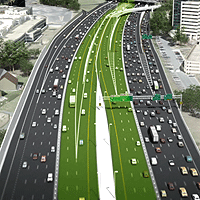 Ron Utt, a Virginia-based Heritage Foundation scholar, and William G. Reinhardt, publisher of Public Works Financing, have offered a balanced appraisal, from a conservative perspective, of public-private partnerships (P3s) as a solution for America’s transportation woes.
Ron Utt, a Virginia-based Heritage Foundation scholar, and William G. Reinhardt, publisher of Public Works Financing, have offered a balanced appraisal, from a conservative perspective, of public-private partnerships (P3s) as a solution for America’s transportation woes.
They cite Virginia’s successes with the Capital Beltway HOT lanes and Hampton Roads tunnels in their essay, “Can Public-Private Partnerships Fill the Transportation Funding Gap?”
But Utt and Reinhardt acknowledge that there is stiff public resistance to the tolls required to pay for multibillion-dollar improvements.
Policymakers should recognize that P3s are not the solution to the transportation infrastructure investment gap that threatens to undermine commerce in the United States. There are too few financially viable P3 projects to meet the national need for new highway capacity and to modernize existing roads. No amount of enabling legislation will bring private investors into projects that are not financeable, and very few highways could support themselves on tolls alone. Thus, some combination of gas taxes, sales taxes, fees, and appropriations of state funds is necessary to make a creditworthy public–private partnership. …
P3s have demonstrated the ability to raise substantial sums of money for major infrastructure projects, especially to add needed capacity in congested corridors. Experience has also demonstrated that P3 projects can be complicated and time-consuming to create and that not every transportation project is amenable to this approach. As a consequence, other innovative and traditional finance solutions will be needed to meet current and future infrastructure spending plans.
Those are all worthy points but I would append one more critical question: How do we ensure that P3s are economically justified? As Utt and Reinhardt point out, few projects can support themselves on the basis of toll revenues alone. Most P3s require public subsidies to buy down the price of the tolls. If the demand doesn’t exist to support the improvement, or if private-sector players aren’t willing to assume the risk that toll revenues may not materialize, should the project be built at all? I have yet to see a set of clearly articulated principles by which to judge when a public subsidy of a P3 project is warranted.
— JAB


